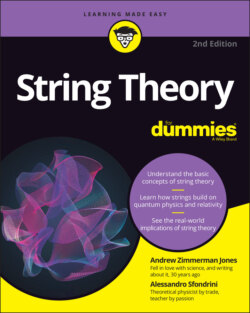Читать книгу String Theory For Dummies - Andrew Zimmerman Jones - Страница 35
A MATTER OF MASS
ОглавлениеWhen we say that the force between objects is proportional to the mass of the two objects, you may think this means that heavier things fall faster than lighter things. For example, wouldn’t a bowling ball fall faster than a soccer ball?
In fact, as Galileo showed (though not with modern bowling and soccer balls) years before Newton was born, this isn’t the case. For centuries, most people had assumed that heavier objects fall faster than light objects. Newton was aware of Galileo’s results, which was why he was able to figure out how to define force the way he did.
By Newton’s explanation, it takes more force to move a heavier object. If you dropped a bowling ball and a soccer ball off a building (which we don’t recommend), they would accelerate at the exact same rate (ignoring air resistance) — approximately 9.8 meters per second squared.
The force acting between the bowling ball and Earth would be higher than the force acting on the soccer ball, but because it takes more force to get the bowling ball moving, the actual rate of acceleration is identical for the two balls.
Realistically, if you performed the experiment, there would be a slight difference. Because of air resistance, the lighter soccer ball would probably be slowed down if dropped from a high enough point, while the bowling ball would not. But a properly constructed experiment, in which air resistance is completely neutralized (like in a vacuum), shows that the objects fall at the same rate, regardless of their mass.
The fact that the force is divided by distance squared means that if the same two objects are closer to each other, the power of gravity increases. If the distance gets wider, the force drops. The inverse square relationship means that if the distance doubles, the force drops to one-fourth of its original intensity. If the distance is halved, the force increases by four times.
If the objects are very far away from each other, the effect of gravity becomes very small. The reason gravity has any impact on the universe is because there’s a lot of it. Gravity itself is very weak, as forces go.
The opposite is true as well. If two objects get extremely close to each other — and we’re talking extremely close here — then gravity can become incredibly powerful, even among objects that don’t have much mass, like the fundamental particles of physics.
This isn’t the only reason gravity is observed so much. Gravity’s strength in the universe also comes from the fact that it’s always attracting objects together. The electromagnetic force sometimes attracts objects and sometimes repulses them, so on the scale of the universe at large, it tends to counteract itself. Finally, gravity interacts at very large distances, as opposed to some other forces (the nuclear forces) that only work at distances smaller than an atom.
We delve a bit deeper into Newton’s work, both in gravity and in related areas, in Chapter 5.
Despite the success of Newton’s theory, he had a few nagging problems in the back of his mind. First and foremost among them was the fact that although he had a model for gravity, he didn’t know why gravity works. The gravity that he described was an almost mystical force (like the Force!), acting across great distances with no real physical connection required. It would take two centuries and Albert Einstein to resolve this problem.
